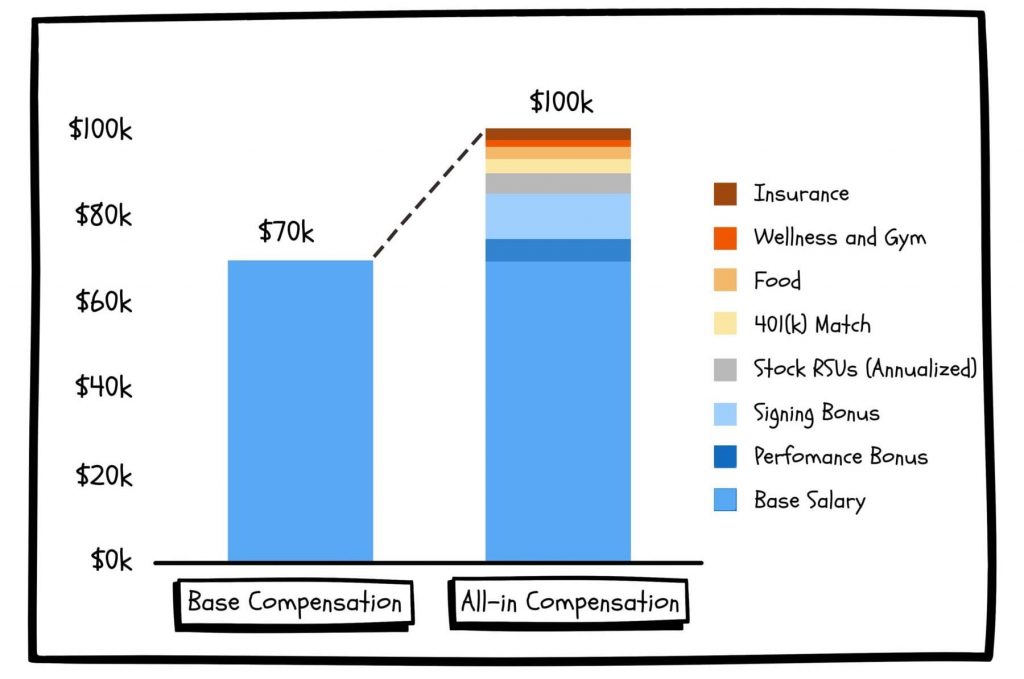What is an employee compensation plan and how to create one

No matter your company size, industry, or business model, you’ll probably agree – organizational success wouldn’t be possible without motivated and productive employees. And one way to motivate your employees is to create an attractive employee compensation plan.
Want to get the most out of your time?
Try DeskTime for free!
Try free for 14 days · No credit card required.
By signing up, you agree to our terms and privacy policy.

What is a compensation plan?
First, we have to understand the concept of employee compensation.
Compensation refers to monetary and non-monetary rewards that employees receive in exchange for their work, time, and expertise. There are two main types of employee compensation: direct and indirect.
The most popular types of direct compensation are:
- Salary – fixed regular payment employees receive every month or every two weeks, often expressed as an annual sum
- Hourly wage – a predetermined amount in the local currency employees receive per hour of their work
- Commission – compensation based on the employees’ performance, eg., the volume of services performed, products created, or sales made
- Bonuses – compensation used to motivate employees, usually paid if employees (or the company) reach their sales, performance, or productivity goals
Besides direct compensation, there are also several types of indirect compensation. To name a few:
- stock options
- profit sharing
- benefits (healthcare, paid leave, etc.)
- non-monetary compensation (work meals, paid holidays, company car, etc.)
- and more
Now, an employee compensation plan defines what is included in an employee compensation package, when and for what purpose employees can receive bonuses and other incentives.
The goal of a compensation plan is to both attract people to work for your company and to retain people already working for you. In fact, data shows that a well-thought-out employee compensation model is crucial for attracting new talent – 67% of respondents said salary is the top factor for them when choosing a job, while for 63% those are the benefits.
Bear in mind that perks like Pizza Fridays, ping-pong tables in the office, or branded hoodies will never substitute fair compensation. While employees can see these perks as a nice bonus, they won’t be the reason people will apply for your vacancy or stay at your company. At the end of the day, perks don’t pay the bills.

How to make an employee compensation plan for your company?
According to the job site Indeed, retaining employees is one of the biggest challenges businesses face. At the same time, a thought-out compensation program can help you remain competitive in the job market and make sure your employees stay loyal.
Now, how do you create an employee compensation plan?
Step 1: Analyze the existing situation in the market
In other words, do your compensation plan research. Find out how much is being paid for what positions, what responsibilities, competencies, and years of experience. Research the latest compensation trends in your industry, for example, what monetary and non-monetary benefits and performance-based bonuses employees are offered.
There are several ways you can find this information out, for example:
- Check out your local job posting sites (bear in mind that compensation amounts can differ by location, too)
- Take a look at the job section on your competitors’ websites
- Survey your own employees to find out what types of compensation are important to them
- Invest in purchasing a salary survey, eg., from a consulting company, trade organization or association, or other survey organization
- Set up a social media survey, for example on LinkedIn, to grasp a general idea of the expectations people have about compensations
Step 2: Decide how much you’ll be paying for what positions
Once you’ve familiar with the existing situation in the job market, the next step is to understand how much you’ll be offering your employees.
Here’s a way to do it:
Start with defining all the job positions you need to fill and group them into categories (eg., by department, seniority, geographical location, etc.). Then, for each of the categories, indicate the market’s minimum to average compensation amplitude.
Next, understand where you’re ready to go above the market. Meaning – decide which positions are crucial to your business and thus worth paying above the average (and by how many percent exactly) to attract and retain the very best talent. Additionally, write down other factors that can affect the pay, such as, special skills, years of experience, education, etc. Again, decide by what percentage each of these factors will affect the pay.
For example, you might see the growth marketer position as extremely important for your business, and thus would be ready to pay 15% above the market average. Or you might find experience crucial for some positions, therefore you’d be ready to pay an extra 10% per every 5 years of experience.
Now, calculate the compensation amplitude for each of the categories and special-importance positions in your company. This will be the base pay you’ll be offering – the pay that will be paid out regardless of employees meeting their goals or not.
Step 3: Identify the other benefits and incentives that you will provide
Other benefits and incentives can include compensations like commissions or yearly bonuses, profit sharing, health insurance, gym membership, company car, and many more. Decide what exactly you will offer to your employees to attract them to your company, motivate them and make them stay. In other words, create your employee benefit plan.

Source: 2 by 22
For example, if you will offer a commission to your salespeople, then how much? Or if you will offer stock options to your employees, then under what conditions?
The commissions and bonuses will be your company’s variable pay – the pay that employees will receive if they hit their work goals.
Step 4: Make sure your compensation plan makes sense
When you’ve put your ideal employee compensation plan together, calculate how much it will cost the company. Does it make financial sense to your business? If yes, go ahead and implement it. If no, go back to step #2 to see what can be adjusted.

Want to prevent overworking?
Prioritize and set healthy boundaries!
Should you adjust your compensation plan for remote employees?
To adjust or not the company’s compensation program for remote employees has recently become a hot question.
According to Gartner, 88% of the organizations, worldwide, made it mandatory or encouraged their employees to work from home after COVID-19 was declared a pandemic. Now that things are slowly getting better, it turns out that people don’t want to return to the old normal. A DeskTime survey shows that 60% of office workers either want to stay remote or prefer a hybrid work model, combining both remote and office-based work.
While many companies are okay with such a decision and even have gone 100% officeless, others, apparently, are not.
In 2021, Google, the tech giant that has long been considered as one of the best places to work, announced that they’re planning to cut remote workers’ salaries by up to 25%. The pay cut would affect fully remote employees who would decide to leave San Francisco (where the company’s HQ is located) for a less expensive area or state.
“Our compensation packages have always been determined by location,” a Google spokesperson said Reuters, adding that remote workers’ pay will differ from city to city and state to state. Companies like Facebook and Twitter have also decided to go the same route.
If some of the top Silicon Valley companies do it, is such a practice okay, and should you, too, adjust your compensation plan for remote workers?
That’s a question for you to answer, however here are two things you should keep in mind if you decide to cut your remote workers’ pay:
One, a pay cut may make your remote workers feel undervalued and that can impact their performance. If two people are doing the same job, but are paid differently, it does raise a question of whether in-office workers are more valuable than those working from home. And if that’s the case, why should they bother to be as productive and efficient?
And two, a pay cut is a short-term advantage. Your business might save money at first, but in the long run, you should be ready to deal with problems like talent attraction, employee retention, employee job satisfaction, and again, with motivation and productivity.

Final words: compensation is not the only motivation for employees
Despite compensation being one of the major motivators for employees, it’s not the only one. And the ”great resignation of 2021” is great proof of it.
The great resignation refers to a mass, voluntary exodus from the workforce. According to the US Department of Labor, during the months of April, May, and June 2021, a total of 11.5 million workers quit their jobs for various reasons. While some left their jobs for better pay, millions of others moved on because they realized that their jobs weren’t a good fit or were too stressful and caused burnout, or because they weren’t satisfied with how the management handled the COVID-19 crisis.
Lesson learned?
Besides creating a good employee compensation plan, you should also pay attention to building a strong company culture, where people are being valued, have room to grow and put their talents to use, and are given time to take rest and care of their wellbeing.
Did you find this article useful? Give it a clap!
Psst! You can clap more than once if you really loved it 🙂